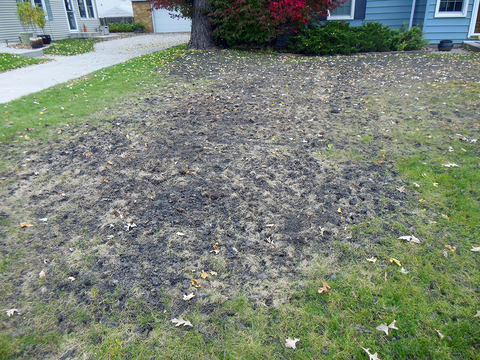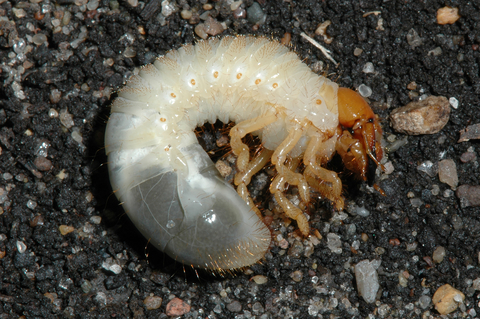Fall turf grass problems? Grubs might be the culprit
UNIVERSITY OF MINNESOTA EXTENSION - www.extension.umn.edu
If you are noticing ugly, dead patches in your lawn, you might have an active population of white grubs. White grubs can cause serious damage to turfgrass. Their feeding injures plant roots, causing the turf to wilt and die.
Symptoms of grub damage include:
- Patchy areas of wilting, discolored or stressed turf that does not respond to irrigation.
- Large irregular patches of dead turf that can be rolled back like a loose carpet.
- Raccoons, skunks and crows tearing up the lawn (looking for grubs to eat).
Lawn damage caused by May-June beetle white grubs
Japanese beetle grub damage
White grubs, what are they?
White grubs are the immature phase, or larvae, of beetles in the scarab family. In Minnesota, white grubs are typically the larvae of May-June beetles and Japanese beetles.
Like all beetles, white grubs undergo complete metamorphosis. Adult beetles lay their eggs in the ground, where the eggs hatch and the beetle larvae live. The beetles progress through the egg stage, several immature (larval) stages, and a non-feeding intermediate (pupa) stage to the adult stage.
The bodies of white grubs grow considerably throughout their life cycle and they move within the soil. White grubs can’t tolerate freezing temperatures; when temperatures cool in the fall, larvae move lower in the soil, below the normal frost line, to survive winter. When the weather warms, they move up to feed on roots.
Different species of white grubs look similar to one another but can be distinguished by the arrangement of hairs and bristles on the underside of their abdomen at the tip called a raster pattern. Raster patterns are challenging to see and recognize; an expert should identify any pest grubs.
Management will differ based on what species of white grub is present in your yard because they have different timing for their life cycles, which means different timing for management.
May-June beetle grub raster pattern
Japanese beetle grub raster pattern
May-June beetles
May-June beetle white grub
May-June beetles have a three-year life cycle. The best time to treat them is during their second year, although damage to turf is usually not noticed then.
Year 1
- Adult beetles emerge in the spring or early summer, in May or June, and lay eggs in the soil.
- Larvae hatch the same summer.
- During the first summer, the larvae feed and grow from the first immature stage to the second.
- Typically, this first year of feeding doesn’t cause noticeable injury.
Year 2
- The following spring, larvae move upward to feed on roots within the first few inches of soil.
- During this second year, the larvae mature into their third larval stage by mid-summer.
- As temperatures fall, the grubs again move lower in the soil profile.
- Second-year damage is more severe than the first year.
Year 3
- In the third spring, the grubs again move up toward the soil surface to feed until fall.
- The mature larvae pupate and then adult beetles emerge from the soil the following spring.
- May-June beetle grubs are typically in the same stage in a given area. Therefore, we commonly see turf damage every three years, when they are in the third year of their life cycle.
- Because they are large and about to turn into adult beetles, it is ineffective to treat the grubs at this point.
Japanese beetles
Japanese beetle grub
Japanese beetles have a one-year (annual) life cycle.
There are two types of treatments: preventive and curative. Preventive treatments are the most effective and are applied in late June and early July as eggs are first being laid. Once grubs are present, late July to September, they can still be treated but management is less effective.
- Grubs move up near the soil surface in the spring to finish feeding and then develop into adult beetles.
- In Minnesota, adult Japanese beetles begin emerging from the ground in late June or early July.
- The adults feed on plants and mate throughout most of the summer months.
- Following mating, females lay their eggs in the soil several different times throughout July and August.
- The eggs hatch in about two weeks and the grubs go through three larval stages during the summer, which is why we may notice turf damage in late summer or early fall.
- Like May/June beetle larvae, Japanese beetle grubs move down in the soil as the weather cools in the fall.
Treating white grubs in the yard
The best time to treat for white grubs is early in their life cycle when the larvae are small, or prior to eggs being laid in the soil. Unfortunately, their presence often goes undetected at that time. Treatment for white grubs in late summer is problematic.
By September, white grubs are fully-grown and are harder to kill. If your white grub issue is May/June beetles, it is most effective to treat them early during their second summer. Severe damage to turf may have already occurred by September.
From Mid-August-October, the following recommendations apply:
- Repair damage through seeding or sodding.
- If loose sod is still green, keep it well watered to encourage root growth.
Give your lawn its best chance by following these steps:
- Select turfgrass that is well adapted for your site.
- Promote a healthy lawn through:
- Proper mowing.
- Fertilization.
- Irrigation.
- Thatch management.
- Weed management.
Healthy turf can tolerate or quickly recover from most insect feeding and serves as the foundation of “integrated pest management” (IPM).
Knowing what type of grub is present in your yard as well as the life-stage of the grubs are useful bits of information as you assess your management options.

